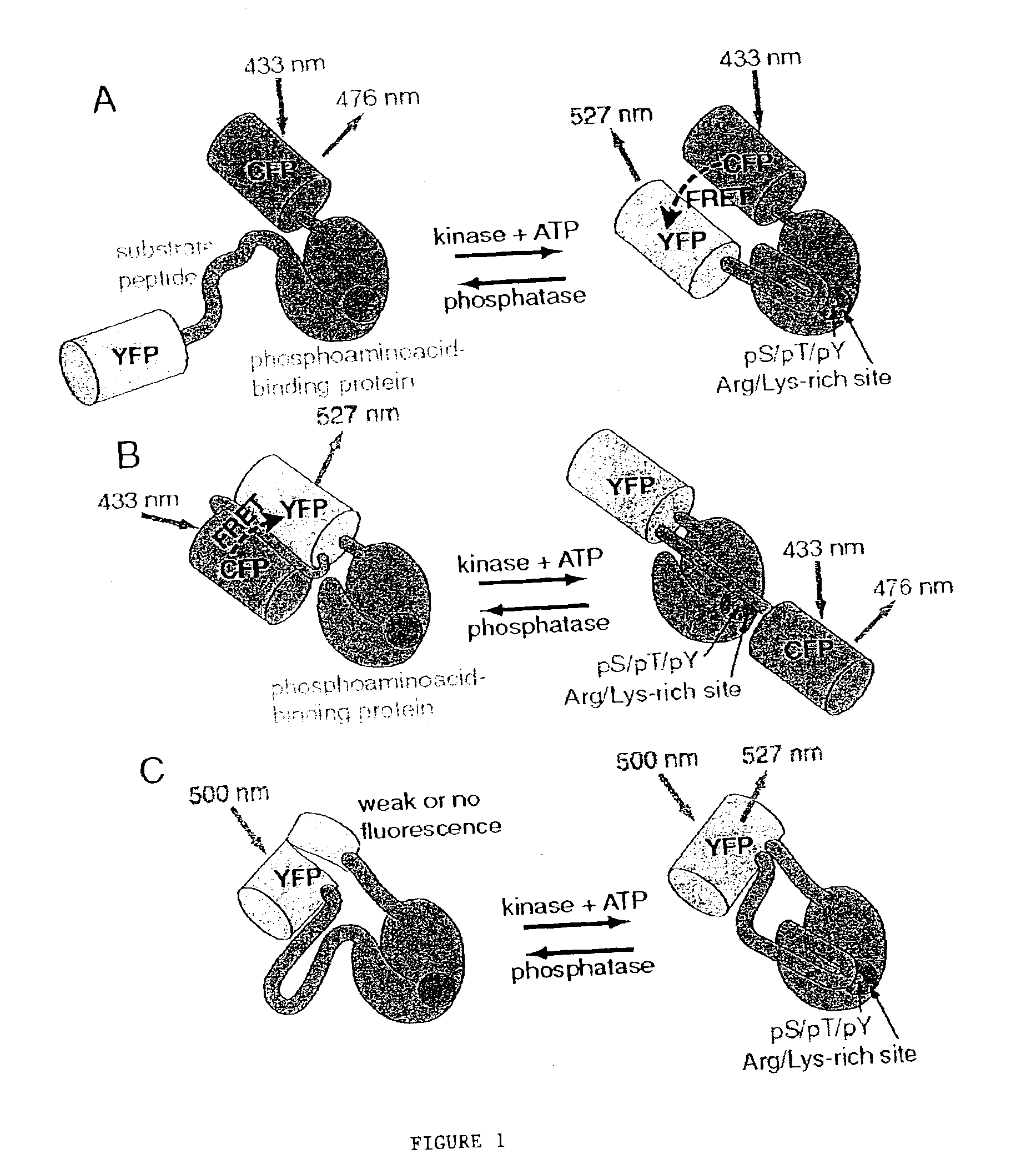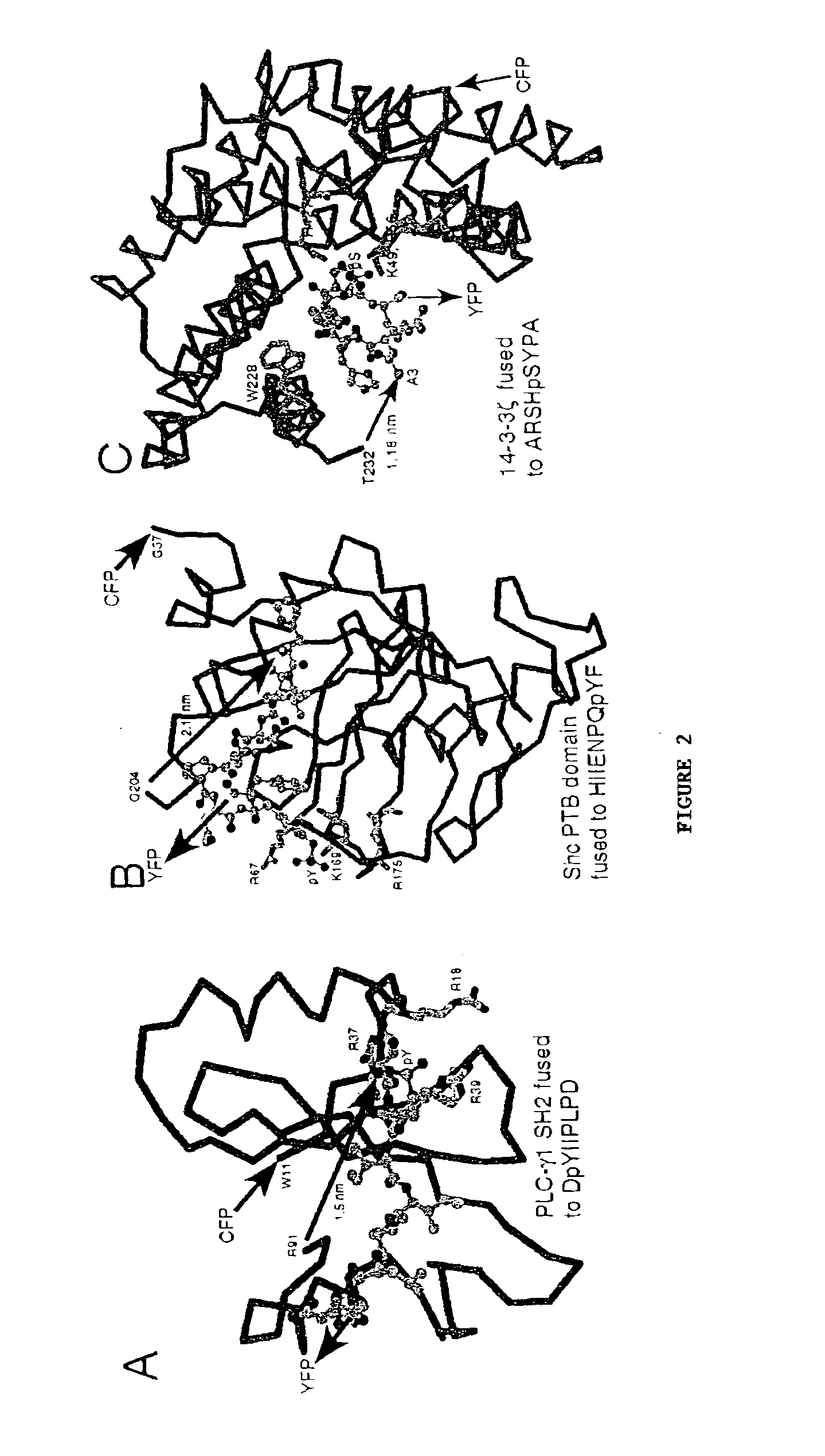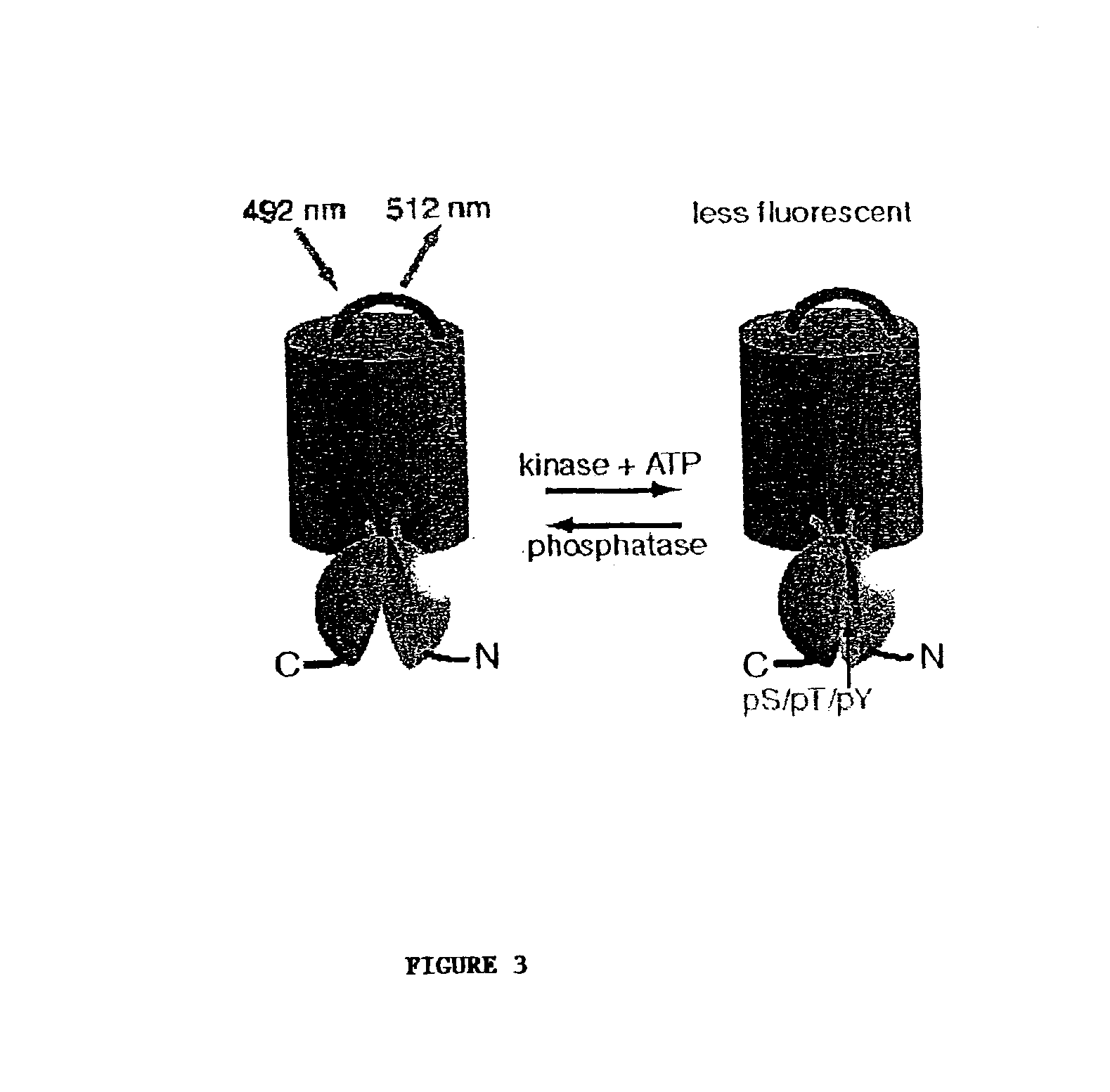Emission ratiometric indicators of phosphorylation
a phosphorylation indicator and emission ratiometric technology, applied in the field of chimeric proteins, can solve the problems of time-consuming and expensive identification of antibodies that can discriminate between a phosphorylated and an unphosphorylated form of a protein, poor temporal and spatial resolution of methods, etc., and achieve the effect of facilitating the translocation of chimeric phosphorylation indicators
- Summary
- Abstract
- Description
- Claims
- Application Information
AI Technical Summary
Benefits of technology
Problems solved by technology
Method used
Image
Examples
example 1
Preparation and Characterization of a Chimeric Reporter Protein for a Serine / Threonine Protein Kinase
[0127]This example provides a method for preparing a chimeric protein kinase A (PKA; cAMP-dependent protein kinase) reporter protein, and demonstrates that such a chimeric reporter molecule can detect serine / threonine kinase activity.
[0128]Plasmid Construction.
[0129]The PKA chimeric reporter protein was constructed by fusing the enhanced cyan fluorescence protein (1-227; ECFP; SEQ ID NO:6; K26R / F64L / S65T / Y66W / N146I / M153T / V163A / N164H), a truncated version of 14-3-3τ, a modified kemptide and citrine, which is an improved yellow fluorescence protein having a sequence as set forth in SEQ ID NO:10, except containing a Q69M mutation. 14-3-3τ (1-232) was amplified using the cDNA of 14-3-3τ (see GenBank Accession No. D87662, which is incorporated herein by reference) in pcDNA3 vector as the template.
[0130]For PCR, the forward primer had the sequence 5′-GGGCATGCATATGGAGAAGACTGAGCTGATCCAG-3′ (...
example 2
Preparation and Characterization of Chimeric Reporter Proteins for Detecting Tyrosine Kinase Activity
[0158]This example provides methods for preparing a chimeric src reporter protein and a chimeric EGFR reporter protein, and demonstrates that such chimeric reporter proteins can detect tyrosine kinase activity.
[0159]Preparation of the Chimeric Gene Encoding the Chimeric EGFR Reporter Protein
[0160]The SH2 domain from mouse p52 Shc (see Lanning and Lafuse, Immunogenetics 49:498-504, 1999; GenBank Accession No. AF054823, each of which is incorporated herein by reference) was amplified by PCR using the following primers:
[0161]
EGFR.Fwd-(5′-GCCGCCCGCATGCATTGGTTCCACGGGAAGCTGAGCCGG-3′;), andSEQ ID NO:38EGFRoptsub.Rev-(5′-TACCATGAGCTCTGATTGCGGAGCCATGTTCATGSEQ ID NO:39TACTCAGCTTCCTCTTCAGGCTTCCCAGATCCAGAGTGAGACCCCACGGGTTGCTCTAGGCACAG-3′;).
[0162]The PCR reaction was assembled as: 67 μl of water, 10 μl of 10×Taq buffer (Promega), 16 μl of 25 mM MgCl2, 2 μl of a 25 mM stock of dNTPs, 1.5 μl of 100...
example 3
Identification of Chimeric Phosphorylation Indicators Using High Throughput Screening
[0187]Based on the results described Examples 1 and 2, additional chimeric phosphorylation indicators can be developed and optimized, using a variety of fluorescent proteins, luminescent molecules, kinase or phosphatase substrates, PAABDs, and tetracysteine motifs. High throughput strategies are particularly useful for systematically generating and testing diverse libraries of such constructs (Zhao and Arnold, Curr. Opin. Chem. Biol. 3:284-290, 1997, which is incorporated herein by reference).
[0188]Initial high throughput diversity generation and screening are performed using the exemplified chimeric phosphorylation indicators (Examples 1 and 2), which are active in mammalian cells. Iterative cycles of variegation, for example (see U.S. Pat. No. 5,837,500, which is incorporated herein by reference), can confer additional useful features on these chimeric reporters. Diversity also can be created by a...
PUM
| Property | Measurement | Unit |
|---|---|---|
| Tm | aaaaa | aaaaa |
| total volume | aaaaa | aaaaa |
| pH | aaaaa | aaaaa |
Abstract
Description
Claims
Application Information
 Login to View More
Login to View More - R&D
- Intellectual Property
- Life Sciences
- Materials
- Tech Scout
- Unparalleled Data Quality
- Higher Quality Content
- 60% Fewer Hallucinations
Browse by: Latest US Patents, China's latest patents, Technical Efficacy Thesaurus, Application Domain, Technology Topic, Popular Technical Reports.
© 2025 PatSnap. All rights reserved.Legal|Privacy policy|Modern Slavery Act Transparency Statement|Sitemap|About US| Contact US: help@patsnap.com



